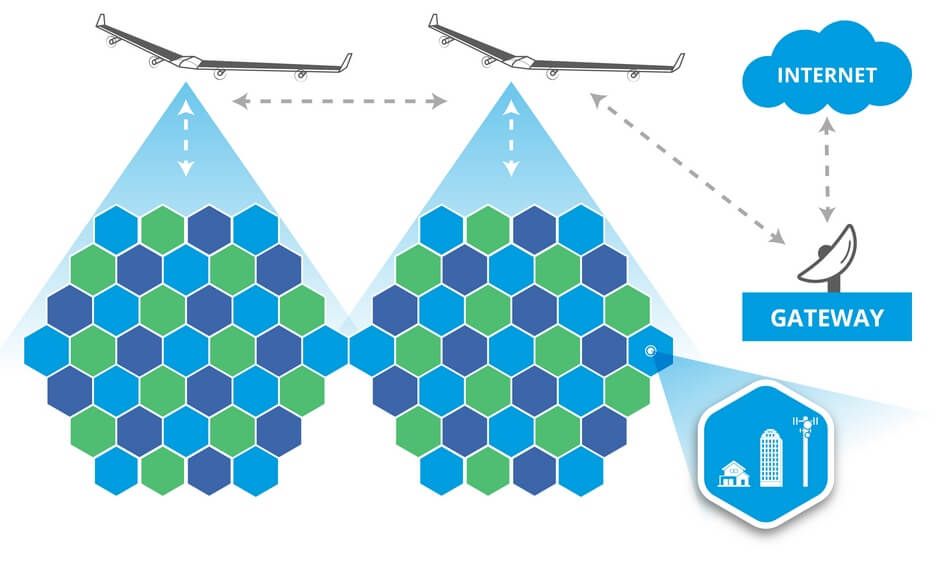HALE System
HALE drones are being designed to operate solely using solar energy. During the day the solar energy is stored in batteries for use during night operation. These drones are expected to last as long as five years, with periodic maintenance repairs. The drones will travel in their cruising orbit for as long as six months before landing for maintenance repair. HALE drones have a cruising orbit of a few kilometers in radius, and hover between altitudes of 65k and 90k feet. At night, the drones may descend to lower altitudes in the given range in order to save energy, and ascend during the day, when solar panels are generating energy in order to stay above the 60k feet Class A regulated airspace.
The main infrastructure components of a HALE drone based broadband access system are the drone, the communications payload on the drone, and the gateway equipment. Ubiqomm’s drone communications system design has been optimized to achieve very high throughput to minimize the infrastructure cost per bit to make the connectivity cost as low as possible. Ubiqomm’s system has also been designed and optimized to minimize the cost of the Customer Premises Equipment (CPE) such as communications devices attached to the low altitude drones, terminals installed at homes/enterprises and on aircraft/ships. Ubiqomm’s focus has been to design a HALE drone based broadband access system that is the most competitive access system among all access technologies.

As illustrated in the figure above, the HALE drone generates multiple beams to cover a target area on the ground with diameter as small as 40 km and as large as 100 km. The figure shows 19 beams per drone coverage area. The Ubiqomm baseline HALE drone communications system may use as many as 37 beams in order to maximize the total throughput of the drone. Note that as mentioned above, the HALE drone is traveling in a cruising orbit of a few kms in radius, as well as vertically with direction depending on time of day. The vertical movement of the drone is much slower than the circular movement as the drone may move lower vertically several kilometers during night and then move vertically up several kilometers during the day. The circular movement of the drone is, however, much faster completing one circle in 10 to 30 minutes. If the beams generated by the drone are fixed with respect to the drone, then the beams will move on the ground as the drone circles in its orbit, in which case the CPEs on the ground need to be handed off from one beam to the next. A HALE drone payload whose beams are fixed with respect to the drone is more power efficient, less expensive, and more robust. The main benefit of a system where the drone beams are fixed with respect to the ground is the ability to target the beams to specific areas with high density of traffic.
In order to maximize the total throughput of one HALE drone, the drone communications payload must be designed to be highly power efficient. The lower the power consumption of the payload, the higher the total drone throughput. The Ubiqomm HALE drone broadband access technology uses multiple techniques to minimize the power consumption per bit, thereby maximizing the total throughput. One set of techniques strive to use highly power efficient modulation and waveforms. Other techniques optimize the use of power at the system level. Using these multitude of techniques, Ubiqomm system will achieve total throughput of as high as 50 Gbps per drone in a coverage area of diameter ~40 km for the HALE drone payload power allocation being targeted by the HALE drone developers. For deployments where coverage is more paramount (like sparsely populated rural areas), overall system throughput can be traded for providing a greater coverage area.
Ubiqomm has developed a multi-beam prototype payload for HALE drones and has successfully tested the end to end system, including multiple beams that serve the CPEs, the drone steerable gateway antenna, the ground CPE and gateway steerable antennas that track the drone, and handoff of the CPE from beam to beam. This end to end prototype system was recently tested on a general aviation aircraft and all above mentioned functionalities and the corresponding performance targets were successfully demonstrated. The prototype system can now be commercialized by scaling the system to more beams and more bandwidth per beam to achieve very high throughput. The Ubiqomm prototype payload has also passed environmental testing such as the thermal environment where HALE drones and other HAPs platforms operate, and can be tested on a HAPs or HALE drone platform as soon as a platform becomes available.
A study item in WRC-19 is considering spectrum in the mmWave bands for use by HAPs (High Altitude Platforms). Specifically, bands 24.25-27.5 GHz and 38-39.5 GHz are being considered for the downlink in region 2 (Americas) and globally respectively. Bands 21.4 – 22 GHz and 31 – 31.3 GHz are being considered for the uplink in region 2 (Americas) and outside region 2 respectively.